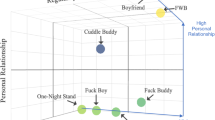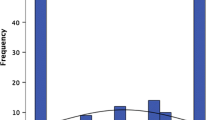Abstract
Using data from a sample of single young men who have sex with men (N = 1,359, ages 18–24, 65 % White, 93 % gay), we examined whether the number of unprotected anal intercourse (UAI) partners with differed across relationship typologies (e.g., friends with benefits, hookups, romantic interests). We then examined how safer sex self-efficacy, decisional balance to forego condoms, ideal relationship attributes (i.e., intimacy, passion and commitment), and limerence were associated with UAI. Different partner types were associated with greater UAI partners; single partner types were associated with fewer UAI partners, irrespective of how they were categorized. UAI partners was associated with decisional balance (OR = 1.89, p < 0.001), passion ideation (OR = 1.38, p < 0.001), and difficulty negotiating safer sex with romantic partners (OR = 1.16, p < 0.001). Odds of UAI partners decreased with higher scores of commitment ideation (OR = 0.91, p < 0.05) and difficulty negotiating safer sex with casual partners (OR = 0.96, p < 0.05). We discuss the importance of acknowledging how different sexual partnerships, alongside its motivational correlates, influence UAI risk in order to inform HIV-prevention interventions.
Resumen
Utilizando datos de una muestra de jóvenes entre las edades de 18-24 años (N = 1,359; 65 % blancos; 93 % homosexuales), examinamos si el número de parejas de sexo anal sin condón (UAI) difería basado en el tipo de pareja (amigos con beneficios, parejas casuales, intereses románticos). Examinamos si el número de parejas UAI estaba asociado con la autoeficacia sexual, balance decisional, atributos de la relación ideal (intimidad, pasión y compromiso), y la infatuación. El número de parejas UAI es mayor entre jóvenes indicando distintos tipos de pareja; el número de parejas UAI es menor cuando se indica un sólo tipo de pareja sexual, independientemente de su clasificación. El número de parejas UAI está asociado con balance decisional (OR = 1.89, p < 0.001), ideación de pasión (OR = 1.38, p < 0.001), y dificultades en la autoeficacia con parejas románticas (OR = 1.16, p < 0.001). El número de parejas UAI está negativamente asociado con la ideación de compromiso (OR = 0.91, p < 0.05) y las dificultades de autoeficacia con parejas casuales (OR = 0.96, p < 0.05). Discutimos la importancia de reconocer como diferentes parejas sexuales, adjunto a sus motivaciones, influyen en el UAI de los jóvenes con el fin de informar intervenciones para prevenir VIH.
Similar content being viewed by others
References
U.S. Centers for Disease Control and Prevention: Estimated HIV incidence in the United States, 2007–2010. HIV Surveill Suppl Rep. 17 [Internet]. http://www.cdc.gov/hiv/pdf/statistics_hssr_vol_17_no_4.pdf (2012). Cited 1 March 2014. Accessed 12 Oct 2014.
Eaton DK, Kann L, Kinchen S, Shanklin S, Flint KH, Hawkins J, et al. Youth risk behavior surveillance—United States, 2012. MMWR Surveill Summ. [Internet]. 2007;61:1–162.
Harper GW. Sex isn’t that simple: culture and context in HIV prevention interventions for gay and bisexual male adolescents. Am Psychol. 2007;62:803–19.
Mustanski BS, Newcomb ME, Du Bois SN, Garcia SC, Grov C. HIV in young men who have sex with men: a review of epidemiology, risk and protective factors, and interventions. J Sex Res. 2011;48:218–53.
Pingel ES, Thomas L, Harmell C, Bauermeister J. Creating comprehensive, youth centered, culturally appropriate sex education: what do young gay, bisexual and questioning men want? Sex Res Soc Policy. 2013;10:293–301.
Mustanski B, Hunter J. Parents as agents of HIV prevention for gay, lesbian, and bisexual youth. In: Pequegnat W, Bell CC, editors. Family and HIV/AIDS: cultural and contextual issues in prevention and treatment. New York: Springer; 2012.
Kubicek K, Carpineto J, McDavitt B, Weiss G, Iverson EF, Au C-W, et al. Integrating professional and folk models of HIV risk: YMSM’s perceptions of high-risk sex. AIDS Educ Prev. 2008;20:220–38.
Kubicek K, Carpineto J, McDavitt B, Weiss G, Kipke M. Use and perceptions of the Internet for sexual information and partners: a study of young men who have sex with men. Arch Sex Behav. 2011;40:803–16.
Eisenberg A, Bauermeister J, Johns MM, Pingel E. Achieving safety: safer sex, communication, and desire among young gay men. J Adolesc Res. 2011;26:645–69.
Bruce D, Harper GW, Fernández MI, Jamil OB. Age-concordant and age-discordant sexual behavior among gay and bisexual male adolescents. Arch Sex Behav. 2012;41:441–8.
Outlaw AY, Phillips G, Hightow-Weidman LB, Fields SD, Hidalgo J, Halpern-Felsher B, et al. Age of MSM sexual debut and risk factors: results from a multisite study of racial/ethnic minority YMSM living with HIV. AIDS Patient Care STDs. 2011;25(Suppl 1):S23–9.
Wohlfeiler D, Potterat JJ. Using gay men’s sexual networks to reduce sexually transmitted disease (STD)/human immunodeficiency virus (HIV) transmission. Sex Transm Dis. 2005;32:S48–52.
Burton J, Darbes LA, Operario D. Couples-focused behavioral interventions for prevention of HIV: systematic review of the state of evidence. AIDS Behav. 2010;14:1–10.
Gomez AM, Beougher SC, Chakravarty D, Neilands TB, Mandic CG, Darbes LA, et al. Relationship dynamics as predictors of broken agreements about outside sexual partners: implications for HIV prevention among gay couples. AIDS Behav. 2012;16:1584–8.
Mitchell JW, Harvey SM, Champeau D, Seal DW. Relationship factors associated with HIV risk among a sample of gay male couples. AIDS Behav. 2012;16:404–11.
Sullivan PS, Hamouda O, Delpech V, Geduld JE, Prejean J, Semaille C, et al. Reemergence of the HIV epidemic among men who have sex with men in North America, Western Europe, and Australia, 1996–2005. Ann Epidemiol. 2009;19:423–31.
Epstein M, Calzo JP, Smiler AP, Ward LM. “Anything from making out to having sex”: men’s negotiations of hooking up and friends with benefits scripts. J Sex Res. 2009;46:414–24.
Owen J, Fincham FD. Effects of gender and psychosocial factors on “friends with benefits” relationships among young adults. Arch Sex Behav. 2011;40:311–20.
Bauman LJ, Berman R. Adolescent relationships and condom use: trust, love and commitment. AIDS Behav. 2005;9:211–22.
Jonason PK. Four functions for four relationships: consensus definitions of university students. Arch Sex Behav. 2013;42:1407–14.
Bauermeister JA, Leslie-Santana M, Johns MM, Pingel E, Eisenberg A. Mr. Right and Mr. Right Now: romantic and casual partner-seeking online among young men who have sex with men. AIDS Behav. 2011;15:261–72.
Bandura A. Social cognitive theory: an agentic perspective. Annu Rev Psychol. 2001;52:1–26.
Bauermeister JA, Hickok AM, Meadowbrooke C, Veinot T, Loveluck J. Self-efficacy among young men who have sex with men: an exploratory analysis of HIV/AIDS risk behaviors across partner types. AIDS Behav. 2013;18:69–77.
Outlaw A, Naar-King S, Parsons JT, Janisse H, The Adolescent Trials Network. Predictors of condom use in a multi-site study of high-risk youth living with HIV. AIDS Educ Prev. 2010;22:1–14.
Bauermeister JA, Carballo-Diéguez A, Ventuneac A, Dolezal C. Assessing motivations to engage in intentional condomless anal intercourse in HIV risk contexts (“Bareback Sex”) among men who have sex with men. AIDS Educ Prev. 2009;21:156–68.
Slovic P, Peters E, Finucane ML, MacGregor DG. Affect, risk, and decision making. Health Psychol. 2005;24:S35–40.
Kobbeltvedt T, Wolff K. The Risk-as-feelings hypothesis in a Theory-of-planned-behaviour perspective. Judgm Decis Mak. 2009;4:567–86.
Loewenstein GF, Weber EU, Hsee CK, Welch N. Risk as feelings. Psychol Bull. 2001;127:267–86.
Ariely D, Loewenstein G. The heat of the moment: the effect of sexual arousal on sexual decision making. J Behav Decis Mak. 2006;19:87–98.
Sternberg RJ, Weis K. The new psychology of love. New Haven: Yale University Press; 2006.
Bauermeister JA. Romantic ideation, partner-seeking, and HIV risk among young gay and bisexual men. Arch Sex Behav. 2012;41:431–40.
Appleby PR, Marks G, Ayala A, Miller LC, Murphy S, Mansergh G. Consideration of future consequences and unprotected anal intercourse among men who have sex with men. J Homosex. 2005;50:119–33.
Graham JM. Measuring love in romantic relationships: a meta-analysis. J Soc Pers Relatsh. 2010;28:748–71.
Missildine W, Feldstein G, Punzalan JC, Parsons JT. S/he loves me, s/he loves me not: questioning heterosexist assumptions of gender differences for romantic and sexually motivated behaviors. Sex Addict Compulsivity. 2005;12:65–74.
Bauermeister JA, Ventuneac A, Pingel E, Parsons JT. Spectrums of love: examining the relationship between romantic motivations and sexual risk among young gay and bisexual men. AIDS Behav. 2012;16:1549–59.
Bauermeister JA, Pingel E, Zimmerman M, Couper M, Carballo-Dieguez A, Strecher VJ. Data quality in HIV/AIDS web-based surveys: handling invalid and suspicious data. Field Methods. 2012;24:272–91.
Couper MP. Designing effective web surveys. New York: Cambridge University Press; 2008.
Carballo-Diéguez A, Dolezal C, Ventuneac A. Sexual practices assessment schedule. New York: HIV Center for Clinical and Behavioral Studies, Columbia University and New York State Psychiatric Institute; 2002.
Carballo-Diéguez A, Giguere R, Dolezal C, Bauermeister J, Leu C-S, Valladares J, et al. Adherence to rectal gel use among mainly ethnic minority young men who have sex with men during a 3-month placebo gel trial: implications for microbicide research. AIDS Behav. 2014;18:1726–33.
Bauermeister JA, Johns MM, Pingel E, Eisenberg A, Santana ML, Zimmerman M. Measuring love: sexual minority male youths’ ideal romantic characteristics. J LGBT Issues Couns. 2011;5:102–21.
Sternberg RJ. Construct validation of a triangular love scale. Eur J Soc Psychol. 1997;27:313–35.
Tourangeau R, Rips LJ, Rasinski K. The psychology of survey response. Boston: Cambridge University Press; 2000.
Fisher JD, Fisher WA, Misovich SJ, Kimble DL, Malloy TE. Changing AIDS risk behavior: effects of an intervention emphasizing AIDS risk reduction information, motivation, and behavioral skills in a college student population. Health Psychol. 1996;15:114–23.
Carballo-Diéguez A, Ventuneac A, Dowsett GW, Balan I, Bauermeister J, Remien RH, et al. Sexual pleasure and intimacy among men who engage in “bareback sex”. AIDS Behav. 2011;15(Suppl 1):S57–65.
Bancroft J, Janssen E, Strong D. Sexual risk-taking in gay men: the relevance of sexual arousability, mood, and sensation seeking. Arch Sex Behav. 2003;32:555–72.
Kalichman SC, Johnson JR, Adair V, Rompa D, Multhauf K, Kelly JA. Sexual sensation seeking: scale development and predicting AIDS-risk behavior among homosexually active men. J Personal Assess. 1994;62:385–97.
Hoppe T. Circuits of power, circuits of pleasure: sexual scripting in gay men’s bottom narratives. Sexualities. 2011;14:193–217.
Johns MM, Pingel E, Eisenberg A, Santana ML, Bauermeister J. Butch tops and femme bottoms? Sexual positioning, sexual decision making, and gender roles among young gay men. Am J Mens Health. 2012;6:505–18.
Acknowledgments
This research was supported by a NIH Career Development Award (K01-MH087242) to Dr. Bauermeister.
Author information
Authors and Affiliations
Corresponding author
Rights and permissions
About this article
Cite this article
Bauermeister, J.A. Sexual Partner Typologies Among Single Young Men Who Have Sex with Men. AIDS Behav 19, 1116–1128 (2015). https://doi.org/10.1007/s10461-014-0932-7
Published:
Issue Date:
DOI: https://doi.org/10.1007/s10461-014-0932-7




